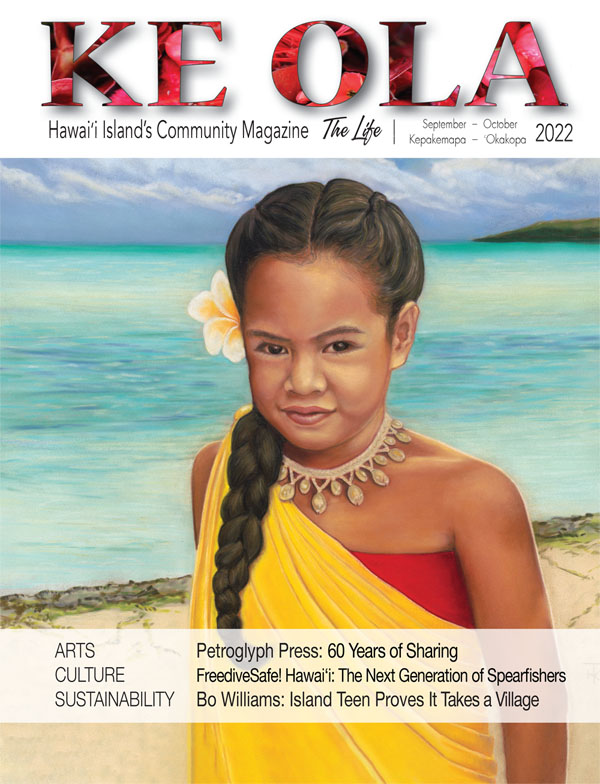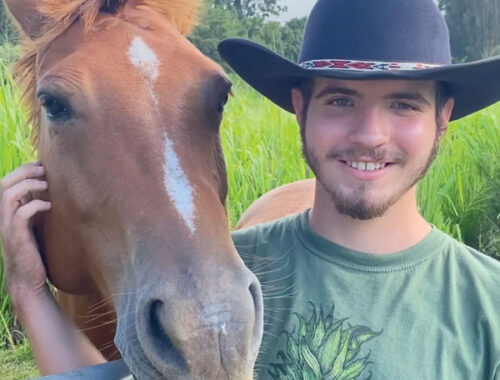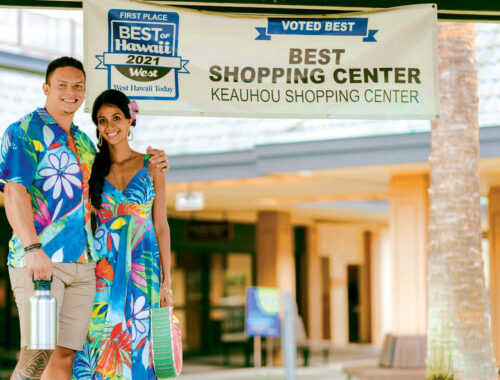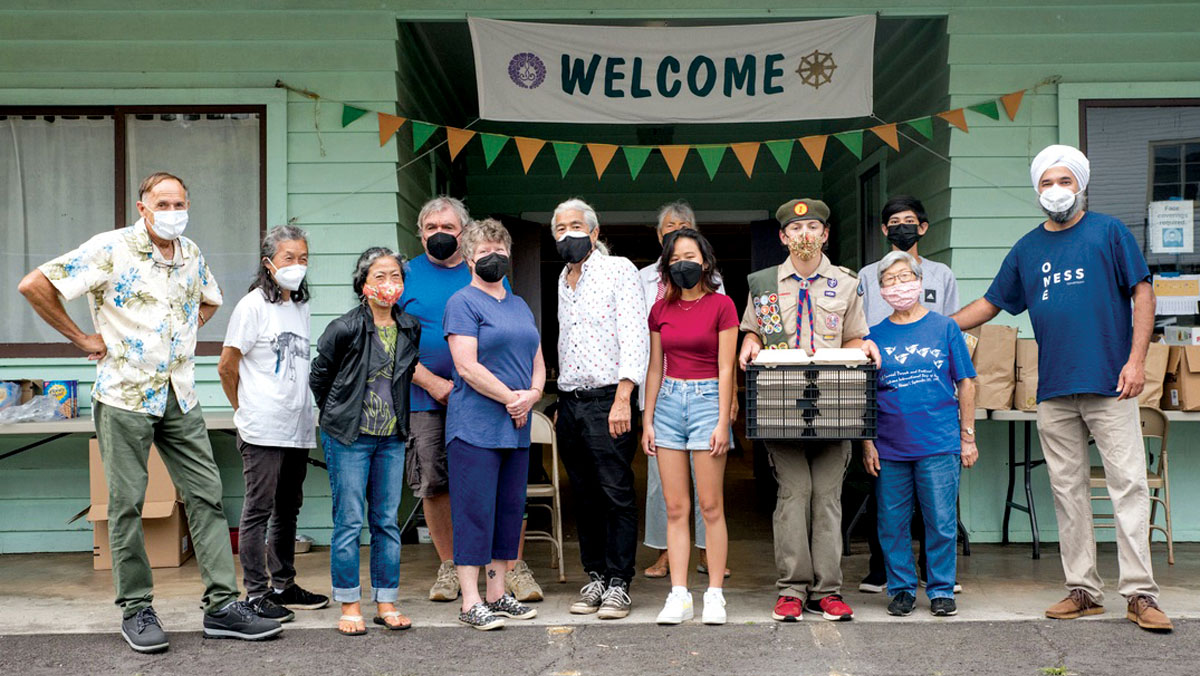
Everyone Wins in Honoka‘a’s Feeding Program
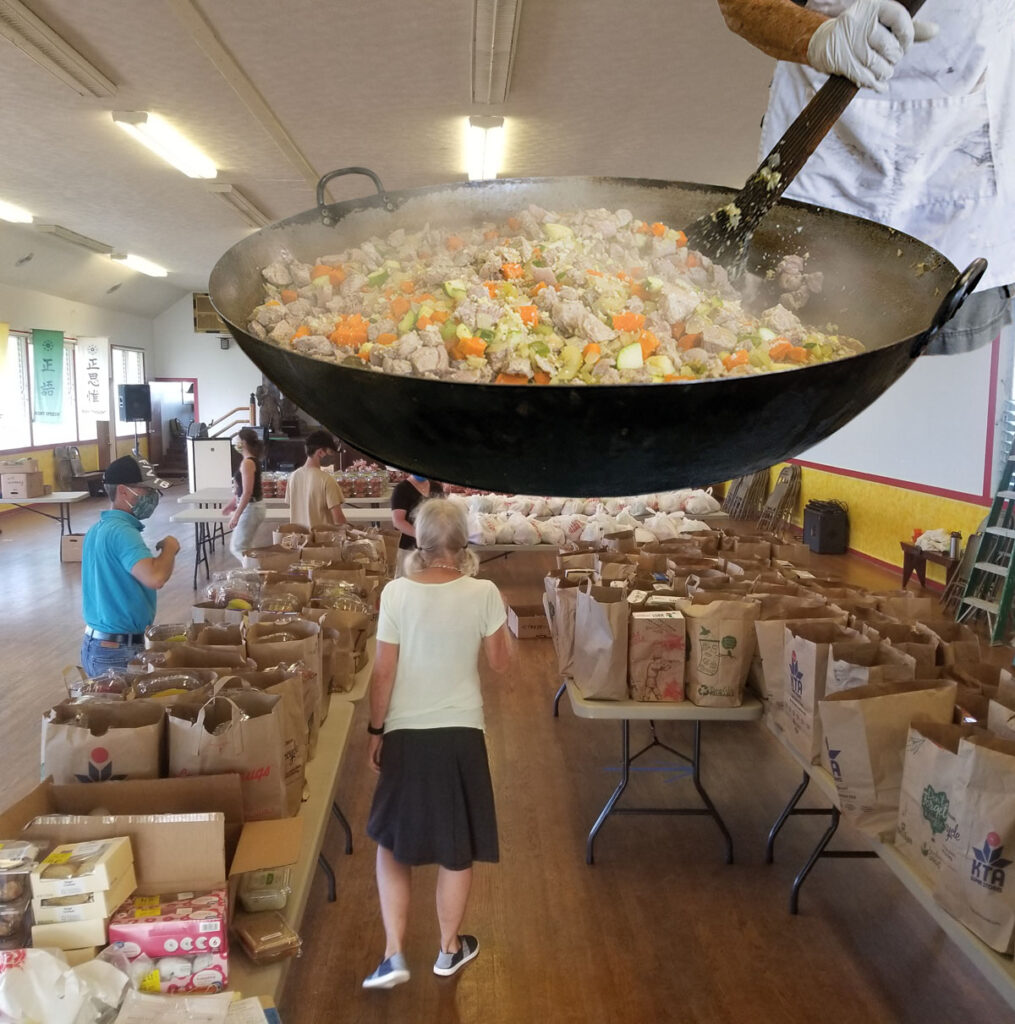
By Catherine Tarleton
Sustainable, adj. 1: capable of being sustained, 2a: of, relating to, or being a method of harvesting or using a resource so that the resource is not depleted or permanently damaged, 2b: of or relating to a lifestyle involving the use of sustainable methods for a sustainable society.
“Everything’s sustainable as long as you have money, and enough volunteerism,” says Miles Okumura, president of Honoka‘a Hongwanji Buddhist Temple, home of Feeding Our Keiki and Kupuna, a food-share program created by the temple’s Peace Committee. The program hands out hot meals and bags of groceries to hundreds of people every Friday, in about 90 minutes.
What started out as an effort to feed kids and elders in need during the onset of Covid-19 quickly grew from 70 to 400 meals per week. In the last three years, the program has served over 35,000 meals, and literally tons of food. They continue to serve about 300 people every week—counting on incoming funds and food donations.
Ravi Singh, co-founder of the program, says, “Food security leads people to have bigger dreams—to truly live to their full potential. I know there’s enough money out there [to help them], we just need to raise it.”
Feeding Our Keiki and Kupuna is based on the concept of langar, an ancient practice in the Sikh tradition of India, where temples serve six million meals per day worldwide. “Langar” (rhymes with hunger) means anchor, and the shared meal, open to all, helps anchor and build community.
Miles, Ravi, and a dedicated squadron of 40–50 volunteers work throughout the week to make it happen, with Friday being the main event. When folks start showing up at 7am, the volunteers divide into various crews for different tasks.
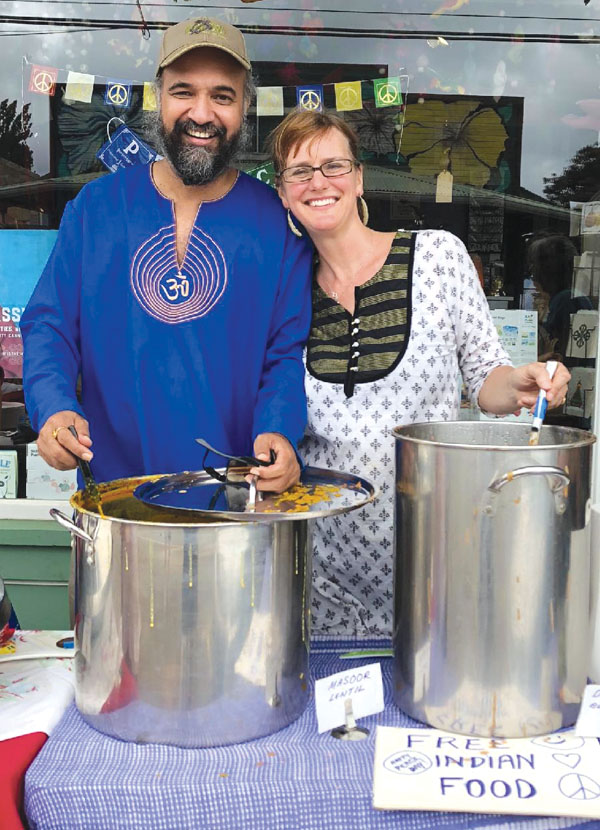
Ravi is in the food prep crew, along with wife Annie Kroeger. They work downstairs in the kitchen, secreted below the 118-year-old temple, where the team chops vegetables for salad and preps ingredients for the cooking crew. Today’s entree is pork and pumpkin curry, from a recipe provided by Sandy Barr-Rivera, formerly with Merriman’s in Waimea. Lenley Lewis, Seny Bynum, and Harriet Burkholder stir a huge wok with a wooden paddle.
“In India, they put out social safety nets so nobody goes hungry,” says Ravi. “That safety net is not from the government, it’s from the temples. At the langar, rich or poor, it makes no difference. All are welcome. Anyone may have a meal and take extra if they need it. We follow that practice here.”
On the weeks when it’s his turn, Ravi cooks Indian food, lentils and cauliflower. Vegetarian, fragrant, and flavorful, his food has earned a bit of a fan base on the island, as people hear about it on the coconut wireless. And—to the astonishment of his Indian family who doesn’t think he can cook—Ravi’s food recently brought in some WWOOFers from a mainland university, when they heard about his cooking and came to Honoka‘a to check it out.
These college students are from World Wide Opportunities on Organic Farms (WWOOF), a volunteer organization that places students with host farms as a kind of cultural and educational exchange. Their goal is to help build the global community and support the sustainability movement.
“Why don’t we do this with local kids?” Ravi says. “We have what many believe to be one of the most beautiful places to live in the world. We have the sun; we have the rain. Some look at this place and see a paradise. In 1999 I started coming here, and I myself was oblivious to the level of food insecurity here. The level of poverty breaks my heart.
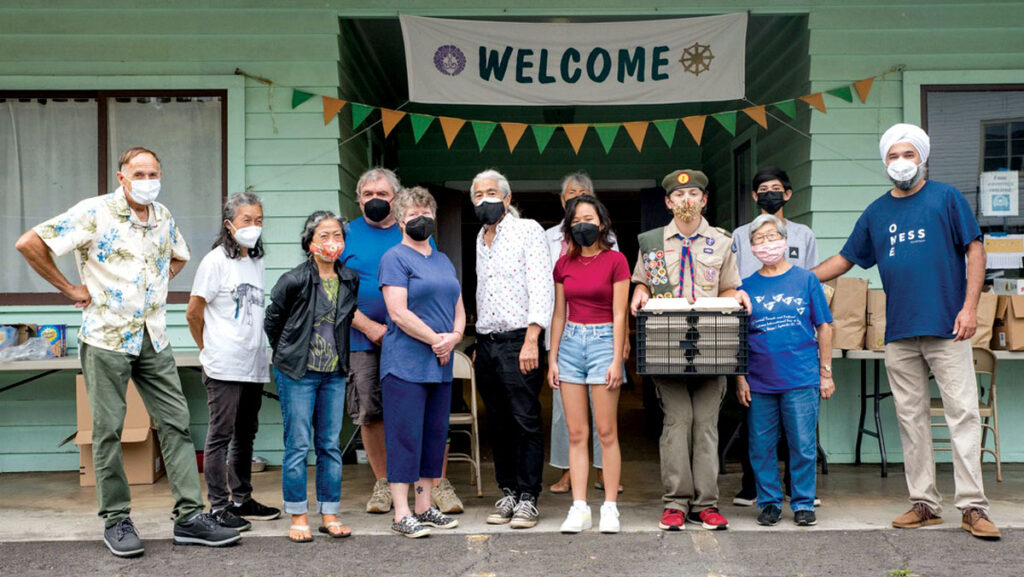
“In India, the Sikh temples have connected with 1,200 organic farmers; we are like the anchor client for them. We tell them, ‘If you grow organic food, we will buy this much at this price and if you have overage—we’re feeding 100,000 people every day—we’ll buy that too.’ My home temple where I grew up served 9.3 million meals in one month during Covid. It’s a central belief…Let’s get food out there. Let’s put out the safety net.”
Work continues. Upstairs, Miles checks on the grocery-bagging crew in the Social Hall. All week long, the temple has been receiving food from local farmers and ranchers, home gardeners, and others. The Food Basket drops off nonperishables by the pallet load. The crew collates bags of fresh food and shelf-stable items for folks to take home, chatting as they work.
“We get two to three thousand pounds of food from a USDA subsidy to the Food Basket, distributed weekly,” says Miles. “This week we got 150 five-pound boxes of frozen chicken, so we can give people a box of chicken, plus some Portuguese sausage, and a gallon of milk this week. Mostly, it’s the cooked meals that are expensive,” says Miles. “Believe it or not, those compostable food trays are our biggest line item: $150 per week. But it’s all sustainable, reliant on donations and volunteers.”
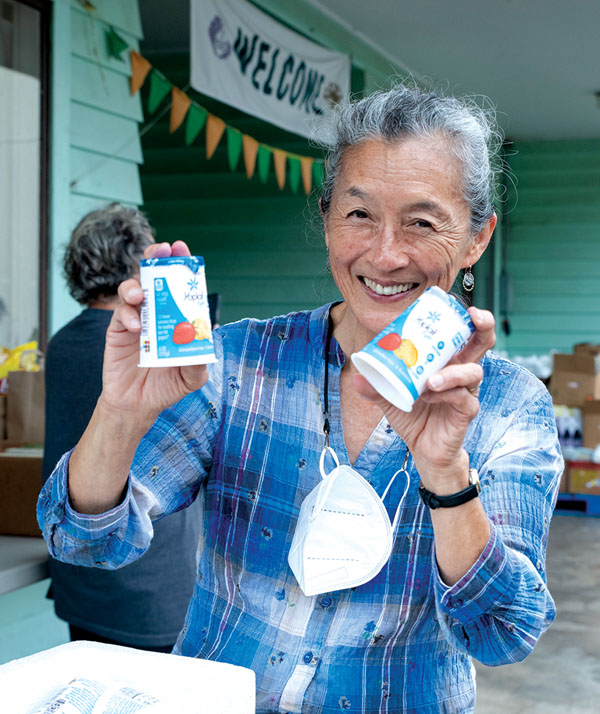
Hawai‘i imports 90% of its food supply, at a cost of about three billion dollars annually, according to The Food Basket, part of the statewide Food Bank organization. Statewide, the Food Bank presently distributes about 65,000 pounds of food each day, working with soup kitchens, food pantries, food gleaning or “rescue” programs, and Community Supported Agriculture programs.
“Food insecurity is really quite high, we are still serving 50% more people than before the pandemic,” says Amy Marvin, CEO of Hawai‘i Food Bank, in a recent interview with KITV. “People still need help. Inflation on top of that has really taken a toll, so we are starting to see more and more people. Last month we saw a 15% increase in the number of people we are serving through our network.”
At the temple, the clock is ticking. Restaurateur Erik Burkhardt and his team finish plating the meal trays, and at 3:30pm, runners carry them upstairs to tables in front of the Social Hall, joining the distribution crew with their platoon of brown paper bags. Miles and the other delivery crew drivers take off. He’ll return at 5:30pm to join the clean-up squad.
At 4pm, it’s go-time. Miles’ wife, Lynn Higashi, and her crew greet the line of cars that trails through the parking lot. One of the younger volunteers, Jason Rodrigues, helps load the food into cars, and young-at-heart Susie Tamashiro (82) has a warm smile for everyone, as windows roll down and she asks how many trays they need. She and Jason help Andi Kaida load grocery bags for the Senior Center.
One of the regulars, Al, beams a bright smile and double shaka. Another, Kevin Gall and his dog Gatorrr, pull up in a pickup bedecked with banana leaves. A few “kitchenless” people talk story in the walk-up line. No one leaves empty handed.
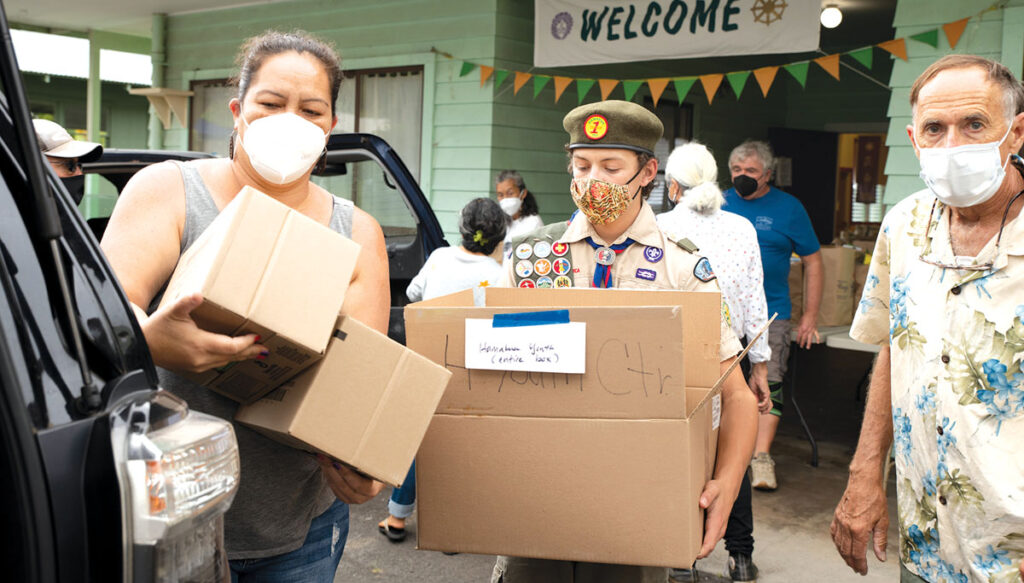
Reaching Farther
On May 1 this year, the feeding program team helped five Ukrainian refugee families, identified through the community’s various connections. They were able to raise $3,000 for these families during the temple’s Buddha’s Birthday Party event.
On May 20, they hosted an Aloha Reception for Marharyta (can be pronounced “Margarita”) Obodovska who recently moved from Ukraine to Hawai‘i Island with her two daughters, while their father is fighting at home. She and her girls came to the Hongwanji for a warm island welcome, lei greeting, and shopping spree at the temple’s thrift store. And, volunteers were able to raise another $2,000.
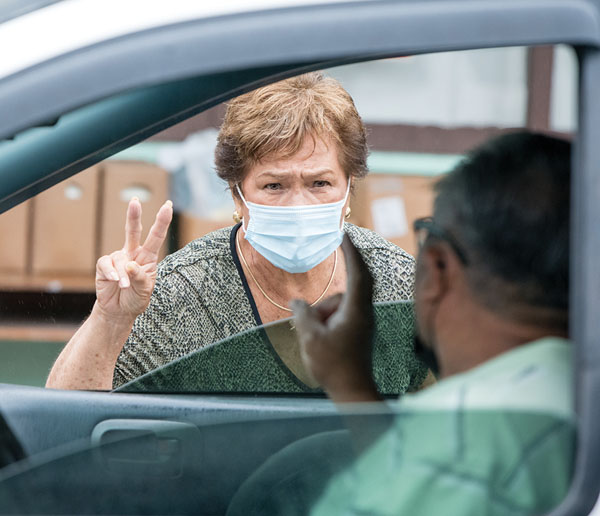
“The Ukraine events were really good, and we want to do more,” says Miles. “It is wonderful to know that our little community can make a big difference to people who we have come to know personally. It’s gratifying. We’ve become a center for doing good things.”
Good things, in addition to warm meals and groceries, also means food for the soul, blessings for both givers and receivers. What Christians call “what would Jesus do,” the Sikhs refer to as seva, selfless service, very similar to the Buddhist idea of dana.
“What the temple has done with the feeding program, is to energize dana, to engage the community as givers,” says Miles. “The program is a good example and practice of this important Buddhist value. But participation is much larger than temple membership. People from the community, and beyond, are creating a new sangha, a community of like-minded friends doing the right thing by sharing food.”
That’s a lot of philosophy, served up along with dinner on a Friday afternoon. “It doesn’t have to be complicated,” Miles says with a smile. “You can just chop veggies, hand out bags, and sometimes promote universal awareness of global interdependence.”
In The Hunger Games, Katniss and her opponents battle for scraps in an impoverished world based on scarcity, need, and competition. Feeding Our Keiki and Kupuna is based on the idea of abundance, plenty, “loaves and fishes,” and having more than enough to share with others, especially in America, and here on Hawai‘i Island. With the help of the the island community, a Hunger Games scenario is easily preventable. ❖
For more information: honokaahongwanjibuddhisttemple.org
